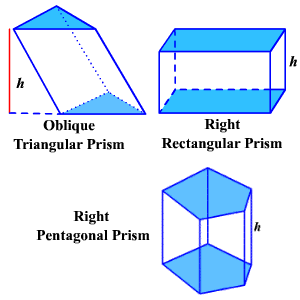How To Find The Surface Area Of A Right Prism
Surface Area of a Prism
The lateral surface surface area of a prism is the sum of the areas of its lateral faces.
The total area of a prism is the sum of the areas of its lateral faces and its two bases.

Usually, if "right" or "oblique" is not mentioned, you can assume the prism is a right prism.
The general formula for the lateral surface area of a right prism is where represents the perimeter of the base and represents the peak of the prism.
Case ane:
Find the lateral expanse of a triangular prism with bases edges inches, inches and inches and altitude inches.

The perimeter is the sum of the bases.
inches
Lateral Area
The general formula for the total surface area of a right prism is where represents the perimeter of the base, the tiptop of the prism and the area of the base.
There is no easy way to summate the surface expanse of an oblique prism in general. The best mode is to find the areas of the bases and the lateral faces separately and add them.
Example 2:
Find the total surface area of an isosceles trapezoidal prism with parallel edges of the base cm and cm, the legs of the base cm each, the altitude of the base cm and peak of the prism cm.

The perimeter of the base is the sum of the lengths of the sides.
Since the base is an isosceles trapezoid, its expanse is .
Source: https://www.varsitytutors.com/hotmath/hotmath_help/topics/surface-area-of-a-prism
Posted by: campnottake.blogspot.com


0 Response to "How To Find The Surface Area Of A Right Prism"
Post a Comment